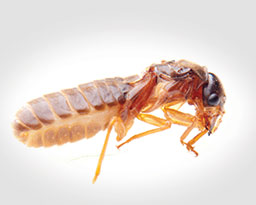FIND YOUR LOCAL
NADER'S SERVICE CENTER
Family Kalotermitidae
Drywood termites are social insects that infest dry wood and do not require contact with the soil. Light brown with narrow, oval-shaped bodies, drywood termites typically shed their veiny wings within minutes of landing, leaving them behind as evidence of an infestation.

| Color | Light brown |
| Legs | 6 |
| Shape | Long, narrow, oval |
| Size | 3/8" to 1" |
| Antennae | True |
Unlike subterranean termite species, drywood termite colonies do not have a worker caste — immature termites do the work before they reach adulthood. Living in colonies of up to 2,700 members, these termites are often capable of causing major damage long before they are discovered.
Larger than most other termite species, drywood termite soldiers can be detected by their large mandibles, which are often wider than their heads.
Since drywood termites require zero contact with the ground to build thriving colonies, they do not dig mud tubes like other species of termites. Known for eating against the grain, drywood termites leave behind erratic, smooth galleries that seldom follow the grain of the wood.
Drywood termites typically swarm during the late summer or fall months, from August through November. Swarms of drywood termites will fly to new homes and buildings in search of wood to infest. They have the ability to cause significant structural damage within months of colonization. Drywood termites also create “kick-out” holes to push their excrement through the wood — leaving behind mounds that resemble sawdust or fine grains of sand.
Drywood termites can be avoided by making sure firewood and scrap wood is stored at least 20 feet from homes and structures. Because drywood termites form new colonies by gaining access to wood through small holes, seal all cracks and crevices in a structure.
For proven-effective termite prevention, experts recommend Sentricon. This trusted termite baiting system provides the most advanced termite protection in the world. Learn more here.
Signs of a mature termite infestation include swarms of winged male and female termites (particularly in warm, rainy weather), which reproduce and fly off to create new colonies. Other signs include mounds of their distinctive, sand-like fecal pellets known as frass, which can indicate an active termite colony. If you notice any of these signs around your home or property, seek a professional termite inspection immediately. To schedule a home inspection, contact us using the form below.
After you submit the information below, a trained professional in your area will get in touch within 1-2 business days to set up a date & time that is convenient for you.